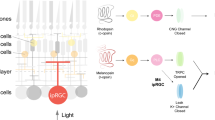Synopsis
It is known that hydrocortisone causes a great increase in the number of small intensely fluorescent (SIF) cells in the sympathetic ganglia when injected into newborn rats. The effect of hydrocortisone on nervous tissuein vitro has not been studied previously.
Pieces of newborn rat sympathetic ganglia were cultivated in Rose chambers. Hydrocortisone was dissolved in the medium in concentrations of 1–9 mg/l. Both control and hydrocortisone-containing cultures were examined daily by phase-contrast microscopy, and the catecholamines were demonstrated histochemically by formaldehyde-induced fluorescence after 7 days in culture.
All cultures showed outgrowths of axons and supporting cells elements, although these were less extensive in the groups of cultures with hydrocortisone. After a week, SIF cells with a green fluorescence were observed in the control explants. In all cultures with hydrocortisone, a concentration-dependent increase was observed in the fluorescence intensity and the number of the SIF cells in the explant; numerous SIF cells were also seen in the outgrowth. Some SIF cells showed processes and the longest processes were seen in cultures with the highest concentration of hydrocortisone.
It is concluded that hydrocortisone causes an increased synthesis of catecholamines in the SIF cellsin vitro, and an increase in their number by affecting either their division or their differentiation from a more immature form, or both. This effect was a direct one and not mediated by any system other than the ganglion itself. Induction of enzyme synthesis by hydrocortisone is proposed as an explanation of the increase in catecholamine concentration.
Similar content being viewed by others
References
Axelrod, J. (1966). Methylation reactions in the formation and metabolism of catecholamines and other biogenic amines.Pharmacol. Rev. 18, 95–113.
Björklund, A., Cegrell, L., Falck, B., Ritzen, M. &Rosengren, E. (1970). Dopaminecontaining cells in sympathetic ganglia.Acta physiol. scand. 78, 334–8.
Burnstock, G., Evans, B., Gannon, B. J., Heath, J. W. &James, V. (1971). A new method of destroying adrenergic nerves in adult animals using guanethidine.Br. J. Pharmacol. 43, 295–301.
Chamley, J. H., Mark, G. E., Campbell, G. R. & Burnstock, G. (1972a). Sympathetic ganglia in culture. I. Neurons.Z. Zellforsch, mikrosk. Anat. (submitted for publication).
Chamley, J. H., Mark, G. E. & Burnstock, G. (1972b). Sympathetic ganglia in culture. II. Accessory cells.Z. Zellforsch. mikrosk. Anat. (submitted for publication).
Chaudhary, K. D., Lupien, P. J. &Hinse, C. (1969). Effect of ecdysone on glutamic decarboxylase in rat brain.Experientia 25, 250–1.
Eränkö, L. & Eränkö, O. (1971a). Effect of hydrocortisone on histochemically demonstrable catecholamines in the sympathetic ganglia and extra-adrenal chromaffin tissue of the rat.Acta physiol. scand. (in press).
Eränkö, L. & Eränkö, O. (1971b). Effect of 6-hydroxydopamine on the ganglion cells and the small intensely fluorescent cells in the superior cervical ganglion of the rat.Acta physiol. scand. (in press).
Eränkö, L. & Eränkö, O. (1971c). Effect of guanethidine on nerve cells and small intensely fluorescent cells in sympathetic ganglia of newborn and adult rats.Acta pharmacol. et toxicol. (in press).
Eränkö, O. &Eränkö, L. (1971d). Small intensely fluorescent, granule-containing cells in the sympathetic ganglion of the rat.Progr. Brain Res. 34, 39–52.
Eränkö, O. &Härkönen, M. (1963). Histochemical demonstration of fluorogenic amines in the cytoplasm of sympathetic ganglion cells of the rat.Acta physiol. scand. 58, 285–6.
Eränkö, O. &Härkönen, M. (1965a). Monoamine-containing small cells in the superior cervical ganglion of the rat and an organ composed of them.Acta physiol. scand. 63, 511–12.
Eränkö, O. &Härkönen, M. (1965b). Effect of axon division on the distribution of noradrenaline and acetylcholinesterase in sympathetic neurons of the rat.Acta physiol. scand. 63, 711–12.
Eränkö, O., Lempinen, M. &Räisänen, L. (1966). Adrenaline and noradrenaline in the Organ of Zuckerkandl and adrenals of newborn rats treated with hydrocortisone.Acta physiol. scand. 66, 253–4.
Grillo, M. A. (1966). Electron microscopy of sympathetic tissue.Pharmac. Rev. 18, 387–99.
Hanks, J. H. &Wallace, R. E. (1949). Relation of oxygen and temperature in the preservation of tissues by refrigeration.Proc. Soc. exp. Biol. (NY).71, 196–200.
Lempinen, M. (1964). Extra-adrenal chromaffin tissue of the rat and the effect of cortical hormones on it.Acta physiol. scand. 62, Suppl. 231.
Matthews, M. R. &Raisman, G. (1969). The ultrastructure and somatic efferent synapses of small granule-containing cells in the superior cervical ganglion.J. Anat. 105, 255–82.
Norberg, K.-A. & Hamberger, B. (1964). The sympathetic adrenergic neuron.Acta physiol. scand. 63, Suppl. 238.
Ritzen, M. (1967). Cytochemical Identification and Quantitation of Biogenic Monoamines. Thesis, Stockholm, P.A. Norstedt & Söner, pp. 63.
Rose, G. C. (1954). A separable and multipurpose tissue culture chamber.Tex. Rep. Biol. Med. 12, 1074–83.
Salk, E. S., Youngner, J. S. &Ward, E. N. (1954). Use of color change of phenol red as the indicator in titrating poliomyelitis virus or its antibody in a tissue culture system. Appendix. Method of preparing medium 199.Amer. J. Hyg. 60, 214–30.
Shelton, K. R. &Alfrey, V. G. (1970). Selective synthesis of a nuclear acidic protein in liver cells stimulated by cortisol.Nature, Lond. 228, 132–4.
Van Orden, L. S., Burke, J. P., Geyer, M. &Lodeon, F. V. (1970). Localization of depletion-sensitive and depletion-resistant norepinephrine storage sites in autonomic ganglia.J. Pharmacol. exp. Ther. 174, 56–71.
Williams, T. H. &Palay, S. L. (1969). Ultrastructure of the small neurons in the superior cervical ganglion.Brain Res. 15, 17–34.
Author information
Authors and Affiliations
Additional information
University of Melbourne Senior Research Fellow, September 1971-August 1972
Sunshine Foundation and Rowden White Trust Overseas Research Fellow in the University on Melbourne, September 1971-August 1972
Rights and permissions
About this article
Cite this article
Eränkö, O., Eränkö, L., Hill, C.E. et al. Hydrocortisone-induced increase in the number of small intensely fluorescent cells and their histochemically demonstrable catecholamine content in cultures of sympathetic ganglia of the newborn rat. Histochem J 4, 49–58 (1972). https://doi.org/10.1007/BF01005268
Received:
Issue Date:
DOI: https://doi.org/10.1007/BF01005268




